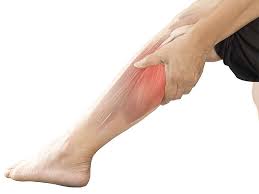
Calf muscle strain is a common injury that can be debilitating if not managed properly. Understanding the anatomy of the calf muscles, recognizing the risk factors, and knowing the symptoms are crucial in effectively treating and preventing this condition. This article will provide a comprehensive guide on how to manage and treat calf muscle strain, covering topics such as immediate treatment options, rehabilitation strategies, and preventative measures to reduce the risk of recurrence. By following the advice outlined in this article, individuals dealing with calf muscle strain can promote healing, regain strength, and return to their regular activities with confidence.
Naprosyn 500 Tablet is a medication designed to alleviate pain. It effectively reduces pain and inflammation associated with various conditions, including osteoarthritis, rheumatoid arthritis, ankylosing spondylitis, gout, and juvenile arthritis. Additionally, it is beneficial for relieving muscle and joint discomfort, headaches, toothaches, and menstrual cramps.
1. Understanding Calf Muscle Strain
Calf Anatomy and Function
Your calves aren't just for show - they play a crucial role in activities like walking, running, and jumping. The calf muscle group consists of the gastrocnemius and soleus muscles, which work together to help you move efficiently.
Types of Calf Muscle Strains
Calf muscle strains can range from mild to severe, with symptoms like pain, swelling, and difficulty walking. Common types include Grade 1 (mild), Grade 2 (moderate), and Grade 3 (severe) strains, depending on the extent of muscle damage.
2. Risk Factors and Causes
Common Causes of Calf Muscle Strain
From overuse during sports activities to sudden movements or improper warm-up, various factors can lead to calf muscle strains. Pushing yourself too hard without proper conditioning can put you at risk.
Risk Factors for Developing Calf Muscle Strain
Factors like age, muscle tightness, inadequate stretching, and improper footwear can increase your chances of experiencing a calf muscle strain. Being mindful of these risks can help prevent future injuries.
3. Symptoms and Diagnosis
Recognizing Symptoms of Calf Muscle Strain
Pain, tenderness, swelling, and difficulty bearing weight on the affected leg are common signs of a calf muscle strain. Listen to your body and seek medical attention if symptoms persist.
Diagnostic Methods for Calf Muscle Strain
Your healthcare provider may perform a physical exam, imaging tests like MRI or ultrasound, and assess your medical history to diagnose a calf muscle strain accurately. Prompt diagnosis can guide appropriate treatment.
Baclof 10 mg tablet is a medication that helps relax muscles. It is also used to manage symptoms from injuries or diseases affecting the spinal cord. The active ingredient in Baclof 10 mg Tablet is baclofen. This tablet is effective in reducing muscle stiffness or tightness caused by conditions related to the brain or spinal cord. Possible side effects of baclofen include nausea, headache, weakness, low blood pressure, and drowsiness.
4. Immediate Treatment Options
RICE Protocol for Calf Muscle Strain
Rest, Ice, Compression, and Elevation (RICE) are key components of initial treatment for calf muscle strains. Giving your muscles time to heal and reducing inflammation can speed up the recovery process.
Medication and Pain Management
Over-the-counter pain relievers like ibuprofen or acetaminophen can help manage pain and reduce inflammation. Your healthcare provider may recommend specific medications or therapies based on the severity of your strain. Remember, it's okay to ask for help when you're in pain - your calves will thank you later!
5. Rehabilitation and Recovery Strategies
So, you've strained your calf muscle. Ouch! But fear not, dear reader, for there are ways to bounce back from this setback. Here are some strategies to help you on your road to recovery:
Physical Therapy Exercises for Calf Muscle Strain
Picture this: You, decked out in your finest sweatpants, engaging in some calf muscle rehab exercises. These exercises can help improve flexibility and strength in your calf muscles, aiding in your recovery process. Think calf raises, gentle stretching, and eccentric exercises – all designed to get you back on your feet in no time.
Gradual Return to Activity
Now, we know you're raring to get back to your usual activities, but slow down there, Speedy Gonzalez. It's crucial to gradually ease back into your regular routine to prevent re-injury. Start with low-impact activities, listen to your body, and resist the urge to sprint back into full-throttle mode. Remember, patience is a virtue (especially when it comes to calf muscle strains).
6. Preventing Calf Muscle Strain Recurrence
Ah, the best defense is a good offense – or in this case, preventing a calf muscle strain from rearing its pesky head again. Here are some tips to keep those calf muscles happy and healthy: Stay limber: Incorporate regular stretching into your routine to maintain flexibility in your calf muscles. Strength training: Building up the strength in your calf muscles can help prevent future strains. Think calf raises, squats, and lunges. Proper footwear: Your shoes play a crucial role in supporting your feet and legs during physical activity. Invest in a pair that provides adequate cushioning and arch support. Warm-up and cool-down: Don't skip these essential steps before and after exercise. A proper warm-up prepares your muscles for action, while a cool-down helps prevent stiffness and aids in recovery. Listen to your body: If something feels off, don't ignore it. Pay attention to any warning signs of potential strain and adjust your activities accordingly. By following these tips and incorporating them into your routine, you'll be well on your way to keeping calf muscle strains at bay. Cheers to happy calves and pain-free strides! In conclusion, proper management and treatment of calf muscle strain are essential for a full recovery and a reduced risk of recurrence. By following the guidelines provided in this article, individuals can navigate the challenges of calf muscle strain effectively, from initial treatment through rehabilitation and prevention strategies. Remember, listening to your body, seeking appropriate medical care, and being proactive in your recovery process are key steps in overcoming calf muscle strain and getting back to peak performance.
Calf muscle strain is a common injury that can be debilitating if not managed properly. Understanding the anatomy of the calf muscles, recognizing the risk factors, and knowing the symptoms are crucial in effectively treating and preventing this condition. This article will provide a comprehensive guide on how to manage and treat calf muscle strain, covering topics such as immediate treatment options, rehabilitation strategies, and preventative measures to reduce the risk of recurrence. By following the advice outlined in this article, individuals dealing with calf muscle strain can promote healing, regain strength, and return to their regular activities with confidence.
1. Understanding Calf Muscle Strain
Calf Anatomy and Function
Your calves aren't just for show - they play a crucial role in activities like walking, running, and jumping. The calf muscle group consists of the gastrocnemius and soleus muscles, which work together to help you move efficiently.
Types of Calf Muscle Strains
Calf muscle strains can range from mild to severe, with symptoms like pain, swelling, and difficulty walking. Common types include Grade 1 (mild), Grade 2 (moderate), and Grade 3 (severe) strains, depending on the extent of muscle damage.
2. Risk Factors and Causes
Common Causes of Calf Muscle Strain
From overuse during sports activities to sudden movements or improper warm-up, various factors can lead to calf muscle strains. Pushing yourself too hard without proper conditioning can put you at risk.
Risk Factors for Developing Calf Muscle Strain
Factors like age, muscle tightness, inadequate stretching, and improper footwear can increase your chances of experiencing a calf muscle strain. Being mindful of these risks can help prevent future injuries.
3. Symptoms and Diagnosis
Recognizing Symptoms of Calf Muscle Strain
Pain, tenderness, swelling, and difficulty bearing weight on the affected leg are common signs of a calf muscle strain. Listen to your body and seek medical attention if symptoms persist.
Diagnostic Methods for Calf Muscle Strain
Your healthcare provider may perform a physical exam, imaging tests like MRI or ultrasound, and assess your medical history to diagnose a calf muscle strain accurately. Prompt diagnosis can guide appropriate treatment.
4. Immediate Treatment Options
RICE Protocol for Calf Muscle Strain
Rest, Ice, Compression, and Elevation (RICE) are key components of initial treatment for calf muscle strains. Giving your muscles time to heal and reducing inflammation can speed up the recovery process.
Medication and Pain Management
Over-the-counter pain relievers like ibuprofen or acetaminophen can help manage pain and reduce inflammation. Your healthcare provider may recommend specific medications or therapies based on the severity of your strain. Remember, it's okay to ask for help when you're in pain - your calves will thank you later!
5. Rehabilitation and Recovery Strategies
So, you've strained your calf muscle. Ouch! But fear not, dear reader, for there are ways to bounce back from this setback. Here are some strategies to help you on your road to recovery:
Physical Therapy Exercises for Calf Muscle Strain
Picture this: You, decked out in your finest sweatpants, engaging in some calf muscle rehab exercises. These exercises can help improve flexibility and strength in your calf muscles, aiding in your recovery process. Think calf raises, gentle stretching, and eccentric exercises – all designed to get you back on your feet in no time.
Gradual Return to Activity
Now, we know you're raring to get back to your usual activities, but slow down there, Speedy Gonzalez. It's crucial to gradually ease back into your regular routine to prevent re-injury. Start with low-impact activities, listen to your body, and resist the urge to sprint back into full-throttle mode. Remember, patience is a virtue (especially when it comes to calf muscle strains).
6. Preventing Calf Muscle Strain Recurrence
Ah, the best defense is a good offense – or in this case, preventing a calf muscle strain from rearing its pesky head again. Here are some tips to keep those calf muscles happy and healthy: Stay limber: Incorporate regular stretching into your routine to maintain flexibility in your calf muscles. Strength training: Building up the strength in your calf muscles can help prevent future strains. Think calf raises, squats, and lunges. Proper footwear: Your shoes play a crucial role in supporting your feet and legs during physical activity. Invest in a pair that provides adequate cushioning and arch support. Warm-up and cool-down: Don't skip these essential steps before and after exercise. A proper warm-up prepares your muscles for action, while a cool-down helps prevent stiffness and aids in recovery. Listen to your body: If something feels off, don't ignore it. Pay attention to any warning signs of potential strain and adjust your activities accordingly. By following these tips and incorporating them into your routine, you'll be well on your way to keeping calf muscle strains at bay. Cheers to happy calves and pain-free strides! In conclusion, proper management and treatment of calf muscle strain are essential for a full recovery and a reduced risk of recurrence. By following the guidelines provided in this article, individuals can navigate the challenges of calf muscle strain effectively, from initial treatment through rehabilitation and prevention strategies. Remember, listening to your body, seeking appropriate medical care, and being proactive in your recovery process are key steps in overcoming calf muscle strain and getting back to peak performance.
